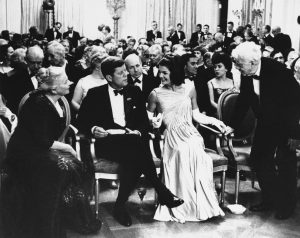Thomas Oliphant in The Washington Post:
 The credit for arguably the best idea ever for a White House event goes to the fertile brain of Richard Goodwin. In a note to Jacqueline Kennedy in November 1961, the president’s aide was to the point: “How about a dinner for the American winners of the Nobel Prize?” Within six months, the largest social event of the New Frontier had occurred. By contemporary accounts, it was a smash. And it has resonated through the decades as a symbol of what that “one brief, shining moment” was capable of on its best days, and of the impact a White House can have on American culture and the creative minds who inhabit it. Comparisons to the disgusting atmosphere of the present are obvious. John Kennedy was pleased, but not entirely. According to his and his wife’s friend, the artist William Walton, the president called him later to complain about the woman who had been seated on his right, Ernest Hemingway’s fourth wife and widow of a year, Mary, who gave him repeated guff for his Cuba policy; Kennedy was more impressed by the dignified woman on his left, Katherine Marshall, the widow of George C. Marshall, the World War II commander and architect of the postwar reconstruction plan that bore his name. “Well, your friend Mary Hemingway is the biggest bore I’d had for a long time,” Walton quoted JFK as saying. “If I hadn’t had Mrs. Marshall I would have had a terrible night.” Walton couldn’t say much in reply: Mary Hemingway was right next to him in his Georgetown home when the call came.
The credit for arguably the best idea ever for a White House event goes to the fertile brain of Richard Goodwin. In a note to Jacqueline Kennedy in November 1961, the president’s aide was to the point: “How about a dinner for the American winners of the Nobel Prize?” Within six months, the largest social event of the New Frontier had occurred. By contemporary accounts, it was a smash. And it has resonated through the decades as a symbol of what that “one brief, shining moment” was capable of on its best days, and of the impact a White House can have on American culture and the creative minds who inhabit it. Comparisons to the disgusting atmosphere of the present are obvious. John Kennedy was pleased, but not entirely. According to his and his wife’s friend, the artist William Walton, the president called him later to complain about the woman who had been seated on his right, Ernest Hemingway’s fourth wife and widow of a year, Mary, who gave him repeated guff for his Cuba policy; Kennedy was more impressed by the dignified woman on his left, Katherine Marshall, the widow of George C. Marshall, the World War II commander and architect of the postwar reconstruction plan that bore his name. “Well, your friend Mary Hemingway is the biggest bore I’d had for a long time,” Walton quoted JFK as saying. “If I hadn’t had Mrs. Marshall I would have had a terrible night.” Walton couldn’t say much in reply: Mary Hemingway was right next to him in his Georgetown home when the call came.
According to author Joseph A. Esposito — whose “Dinner in Camelot” is a delightful, detailed account of the dinner, its background, its repercussions and its lasting meaning — the 127 seated guests (at 19 tables, 14 in the State Dining Room and five more in the Blue Room, where Mrs. Kennedy was located) included 49 Nobel laureates and spouses. The vast majority had toiled in the hard sciences; for the April 29, 1962, affair, the list expanded to include a sprinkling of Latin American luminaries and one Canadian, Lester Pearson.
He was on his way to becoming prime minister after getting a Nobel Peace Prize in 1957 for his efforts as foreign minister to end the fighting over the Suez Canal. It also included several bright lights in the emerging field of American letters. Of the five U.S. winners of the literature prize, three were dead (Sinclair Lewis, Eugene O’Neill and Hemingway); William Faulkner, in his final weeks and under care in Charlottesville, said he thought 100 miles was a bit too far to go for supper; and John Steinbeck, who got his Nobel later that year, pleaded business in Europe. T.S. Eliot, a St. Louis native and eventually a British subject, wasn’t invited; but Pearl Buck was there and briefly debated Korea policy with Kennedy before the post-supper program in the East Room.
More here.
